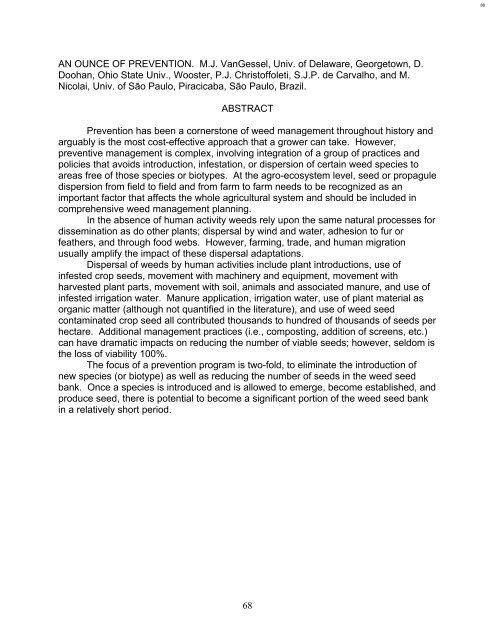Proceedings of the Sixty-first Annual Meeting of the Northeastern ...
Proceedings of the Sixty-first Annual Meeting of the Northeastern ...
Proceedings of the Sixty-first Annual Meeting of the Northeastern ...
Create successful ePaper yourself
Turn your PDF publications into a flip-book with our unique Google optimized e-Paper software.
86<br />
AN OUNCE OF PREVENTION. M.J. VanGessel, Univ. <strong>of</strong> Delaware, Georgetown, D.<br />
Doohan, Ohio State Univ., Wooster, P.J. Christ<strong>of</strong>foleti, S.J.P. de Carvalho, and M.<br />
Nicolai, Univ. <strong>of</strong> São Paulo, Piracicaba, São Paulo, Brazil.<br />
ABSTRACT<br />
Prevention has been a cornerstone <strong>of</strong> weed management throughout history and<br />
arguably is <strong>the</strong> most cost-effective approach that a grower can take. However,<br />
preventive management is complex, involving integration <strong>of</strong> a group <strong>of</strong> practices and<br />
policies that avoids introduction, infestation, or dispersion <strong>of</strong> certain weed species to<br />
areas free <strong>of</strong> those species or biotypes. At <strong>the</strong> agro-ecosystem level, seed or propagule<br />
dispersion from field to field and from farm to farm needs to be recognized as an<br />
important factor that affects <strong>the</strong> whole agricultural system and should be included in<br />
comprehensive weed management planning.<br />
In <strong>the</strong> absence <strong>of</strong> human activity weeds rely upon <strong>the</strong> same natural processes for<br />
dissemination as do o<strong>the</strong>r plants; dispersal by wind and water, adhesion to fur or<br />
fea<strong>the</strong>rs, and through food webs. However, farming, trade, and human migration<br />
usually amplify <strong>the</strong> impact <strong>of</strong> <strong>the</strong>se dispersal adaptations.<br />
Dispersal <strong>of</strong> weeds by human activities include plant introductions, use <strong>of</strong><br />
infested crop seeds, movement with machinery and equipment, movement with<br />
harvested plant parts, movement with soil, animals and associated manure, and use <strong>of</strong><br />
infested irrigation water. Manure application, irrigation water, use <strong>of</strong> plant material as<br />
organic matter (although not quantified in <strong>the</strong> literature), and use <strong>of</strong> weed seed<br />
contaminated crop seed all contributed thousands to hundred <strong>of</strong> thousands <strong>of</strong> seeds per<br />
hectare. Additional management practices (i.e., composting, addition <strong>of</strong> screens, etc.)<br />
can have dramatic impacts on reducing <strong>the</strong> number <strong>of</strong> viable seeds; however, seldom is<br />
<strong>the</strong> loss <strong>of</strong> viability 100%.<br />
The focus <strong>of</strong> a prevention program is two-fold, to eliminate <strong>the</strong> introduction <strong>of</strong><br />
new species (or biotype) as well as reducing <strong>the</strong> number <strong>of</strong> seeds in <strong>the</strong> weed seed<br />
bank. Once a species is introduced and is allowed to emerge, become established, and<br />
produce seed, <strong>the</strong>re is potential to become a significant portion <strong>of</strong> <strong>the</strong> weed seed bank<br />
in a relatively short period.<br />
68
















